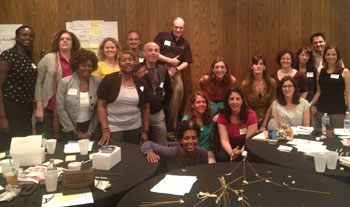Categories: New York City
10.07.2013
"Boot camp" reveals ways to streamline the process of housing the homeless
 In May of this year, a diverse representation from the NYC homeless housing community and Continuum of Care traveled to Chicago for a U.S. Department of Housing and Urban Development (HUD)-sponsored retreat, a.k.a. "boot camp," to brainstorm what our biggest barriers were in housing chronically homeless veterans and other individuals and what we could do in the next 100 days to speed up the process. As a result of these collective efforts, the City is looking toward reducing the very longest time it takes to house a chronically street homeless person by 64%. It's also looking to recapture nearly $10 million in HUD funding.
In May of this year, a diverse representation from the NYC homeless housing community and Continuum of Care traveled to Chicago for a U.S. Department of Housing and Urban Development (HUD)-sponsored retreat, a.k.a. "boot camp," to brainstorm what our biggest barriers were in housing chronically homeless veterans and other individuals and what we could do in the next 100 days to speed up the process. As a result of these collective efforts, the City is looking toward reducing the very longest time it takes to house a chronically street homeless person by 64%. It's also looking to recapture nearly $10 million in HUD funding.
Facilitated by the Rapid Results Institute and 100,000 Homes, the event included the NYC Departments of Homeless Services (DHS), Housing Preservation and Development (HPD) and Health and Mental Hygiene (DOHMH) as well as the Network, Enterprise Community Partners, Homeless Services United, Common Ground, Goddard Riverside Community Center and Samaritan Village. Representatives from these agencies and organizations met for three days in Chicago.
Deciding what to focus on became easy once we cobbled together the following facts:
- NYC is sending back millions each year - an estimated $10 million this year alone in federal homeless housing assistance - because of a flaw in the HUD regulations and inconclusive guidance from Washington on how to keep that money in the city.
- It was taking an estimated 314 days and 24 steps to place our hardest to house - chronically street homeless individuals - into our most complicated supportive housing: NY/NY III housing with project based Section 8 rental subsidies. While it takes considerably less time to house the average homeless person in supportive housing, it was clear from mapping out the process that there was significant room for improvement for all referrals.
- It is difficult to target the inflow of veteran funding toward chronically homeless veterans in NYC because of the data-sharing challenges at the U.S. Department of Veterans Affairs.
One hundred days later and with the help of other key partners in the City, the following has been accomplished:
- Two major steps – and an estimated 75 days – have been removed from the housing process, and an additional five steps and 127 days are expected to be eliminated shortly. In a matter of months, that will have reduced the time to house chronically street homeless individuals by 64%. As part of this effort, DHS announced that it will be allowing direct communication between housing and shelter providers regarding its referrals and is no longer requiring that apartments be officially “ready to rent” before allowing the process of referrals to start – potentially expediting all re-rentals by two weeks.
- A commitment from Mark Johnston, Assistant Secretary of HUD, to provide New York City with a response to the various options HPD and the CoC have proposed for keeping the $10 million in New York City.
- The City has improved its communication around veteran homelessness, in large part thanks to the work the Robin Hood Foundation and CSH had been doing prior to the boot camp but also thanks to DHS and the VA’s continual monitoring of the issue. The street outreach teams have also been critical in the effort to better target resources to chronically homeless vets and, with their first allocation of VASH vouchers, HPD has stepped up its role in the process. As part of the longer term strategy, the VA is also forming a CoC Veterans Task Force.
With record homelessness, it will take more than these steps to end the homelessness crisis in the city. However, the supportive housing community has made incredible strides in a short period of time to better utilize the resources we have.
Picture caption: Participants at a U.S. Department of Housing and Urban Development (HUD)-sponsored event in Chicago map out how to expedite the process of housing homeless individuals in NYC.
